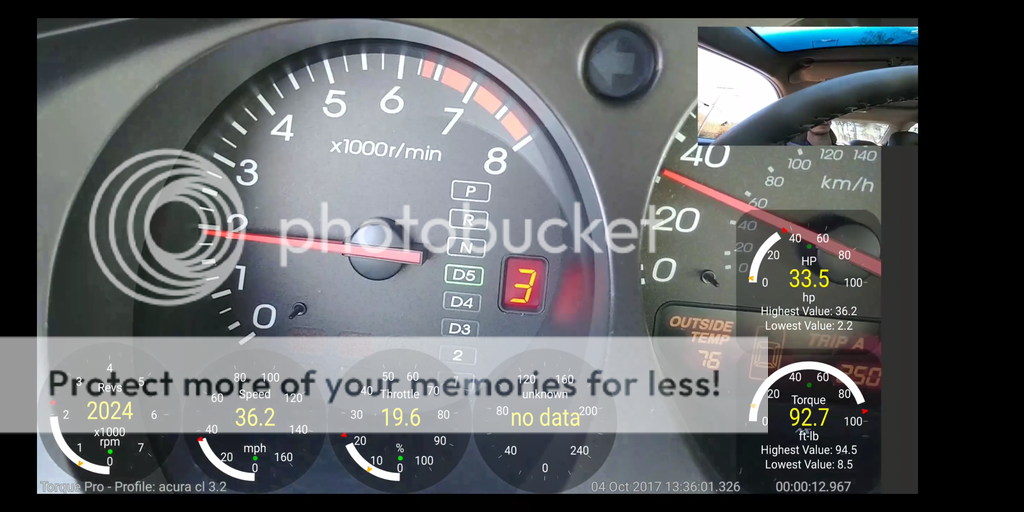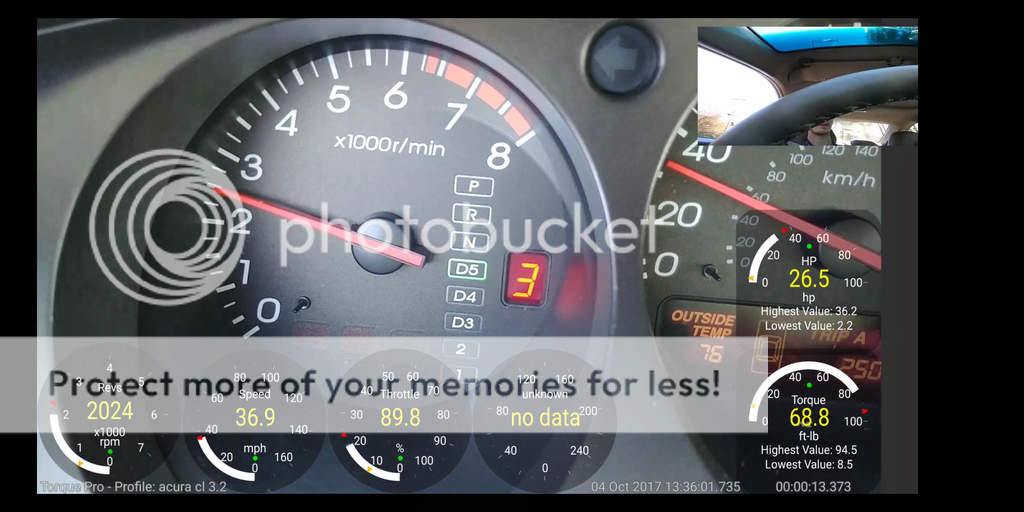what causes RPM's to change in while in gear?
#1
Intermediate
Thread Starter
what causes RPM's to change in while in gear?
When in gear and apply more throttle the rpms will jump up by 500
I have a 2001 acura CL. When I use the sequential sports shift and apply more throttle the RPMs raise by about 500. Say I am in 3rd gear, 2,000 rpm @ 30 mph. When I step on the gas the rpms will go to 2,500 instead of a steady gradual climb from 2,000. 3rd gear @ 3,000rpm is approximately 50 mph. But when I step on it the rpms will go higher than what it should be in that gear at that speed. Same with 4th gear, I could be going 30 mph at 1250 rpm. When I give it more that 25% throttle the rpms will go up to 2,000 and then slowly drop. 2,000 rpm in 4th is 50 mph however I might only be pushing 35-40 at that same rpm. What causes this to happen? Is it the torque converter lock up area or something to do with a 1 to 1 ratio between the engine and transmission? I'm curiouse as to why this is and would this be the case in a manual transmission? Thank you


#2
Welcome,
That's normal. All autos do that. The Helms manual says stall speed is 2200 rpms. Service limit 2050-2350 rpms. It's a compromise between lugging the engine and fuel mileage. It's not good to step on the gas in 3rd at 2000 rpm with a manual transmission because nothing is supposed to slip. At 2000rpm's you're way out of the power band and too much throttle will lug the engine. Autos prevent this by either unlocking the torque converter and allow it to slip like your video or if the rpm's are still too low and too much pedal, it'll down shift. If you're really easy on the gas pedal, the converter will stay locked and rise gradually like a manual transmission. One of the few good things about an automatic, leave it in D and the car will pick the right gear and weather or not to lock the torque converter.
That's normal. All autos do that. The Helms manual says stall speed is 2200 rpms. Service limit 2050-2350 rpms. It's a compromise between lugging the engine and fuel mileage. It's not good to step on the gas in 3rd at 2000 rpm with a manual transmission because nothing is supposed to slip. At 2000rpm's you're way out of the power band and too much throttle will lug the engine. Autos prevent this by either unlocking the torque converter and allow it to slip like your video or if the rpm's are still too low and too much pedal, it'll down shift. If you're really easy on the gas pedal, the converter will stay locked and rise gradually like a manual transmission. One of the few good things about an automatic, leave it in D and the car will pick the right gear and weather or not to lock the torque converter.
#3
Intermediate
Thread Starter
Thank you.I appreciate the explanation. So when the torque converter is locked the engine and transmission will be locked together and depending on the amount of throttle it will unlock and cause this slip because they'll be to much stress on the engine. Similar to when going uphill the car will donwshift for more power.
What is stall and sevrice limit? I noticed that if I'm pressing on throttle and shift through the gears to quick, each gear will start between 2,200- 2,500 rpm no matter the speed. Is this because of the stall limit or service limit?
#4
Stall can be measured in different ways but the Acura manual says to test it by warming up the engine, stepping on the brake at a complete stop, in gear and revving the engine without spinning the tires. When you reach max rpm's or the tires start spinning. thats the stall speed. The designed stall speed is 2200 rpm's. The tolerance is + or - 150rpm. Sevrice limit just means if it's within 2050 and 2350 it's within limits and is serviceable.
Don't do for more than a few seconds because it creates a lot of heat and that's the last thing your transmission needs is more heat.
Don't do for more than a few seconds because it creates a lot of heat and that's the last thing your transmission needs is more heat.
#5
Latent car nut
iTrader: (2)
Join Date: Jan 2017
Location: Southern New Hampshire
Age: 68
Posts: 7,844
Received 2,005 Likes
on
1,407 Posts
I know this thread is about automatic transmissions and the locking and unlocking of the torque converter, but I felt I needed to clear the "lugging" point up a bit.
#6
It's true that with modern engines you can go WOT at a low RPMs with the knock sensors, efi and computers adjusting AFRs and timing so you don't feel the "lugging" but that doesn't mean you're not making the engine work harder than it has to and you'll be way out of the power band.
That's why I said, good things about an automatic, leave it in D and the car will pick the right gear. Wot at 2000 rpms and it'll downshift.
By my calculator, 1500 rpm in 3rd = 20mph. A quick downshift to !st at and rpms will jump to 3400rpms. The engine will be much happier there.
That's why I said, good things about an automatic, leave it in D and the car will pick the right gear. Wot at 2000 rpms and it'll downshift.
By my calculator, 1500 rpm in 3rd = 20mph. A quick downshift to !st at and rpms will jump to 3400rpms. The engine will be much happier there.
#7
Latent car nut
iTrader: (2)
Join Date: Jan 2017
Location: Southern New Hampshire
Age: 68
Posts: 7,844
Received 2,005 Likes
on
1,407 Posts
It's true that with modern engines you can go WOT at a low RPMs with the knock sensors, efi and computers adjusting AFRs and timing so you don't feel the "lugging" but that doesn't mean you're not making the engine work harder than it has to and you'll be way out of the power band.
That's why I said, good things about an automatic, leave it in D and the car will pick the right gear. Wot at 2000 rpms and it'll downshift.
By my calculator, 1500 rpm in 3rd = 20mph. A quick downshift to !st at and rpms will jump to 3400rpms. The engine will be much happier there.
That's why I said, good things about an automatic, leave it in D and the car will pick the right gear. Wot at 2000 rpms and it'll downshift.
By my calculator, 1500 rpm in 3rd = 20mph. A quick downshift to !st at and rpms will jump to 3400rpms. The engine will be much happier there.
The point I'm trying to make is there isn't an engine on the market, and hasn't been since, heck, I don't know, maybe the 1930s, if ever, which will be lugging at 2,000 RPMs, regardless of gear and throttle setting.

